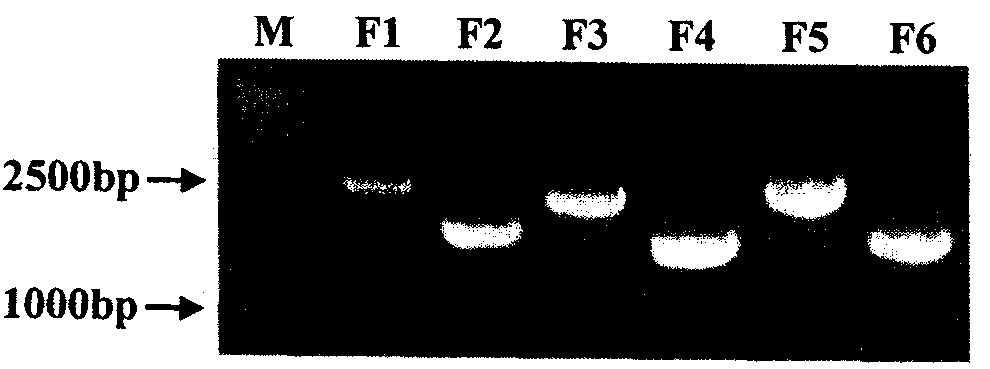Method for constructing hog-cholera virus infectious cDNA carrier having molecule mark
A molecular marker, swine fever virus technology, applied in the biological field, can solve the problem that in-depth research on infectious cDNA is rarely reported, etc.
- Summary
- Abstract
- Description
- Claims
- Application Information
AI Technical Summary
Problems solved by technology
Method used
Image
Examples
Embodiment 1
[0028] Embodiment 1 covers the amplification of CSFV vaccine C strain full-length genome cDNA fragment
[0029] Table 1 is the primers required for amplifying the 6 cDNA fragments of the C strain genome:
[0030]
[0031]
[0032]According to the genome sequence of classical swine fever virus, primers with specific restriction sites were designed in the conserved region. Primer sequences are shown in Table 1. Each fragment was amplified by nested PCR. In the primer name, up means the upstream primer, low means the downstream primer, and new means the primer used for the first round of amplification. The underlined sequence in the primer is the restriction site for cloning the fragment. The sequence in bold in the F1-upper primer is the promoter recognized by the introduced T7 RNA polymerase, and the sequence in bold in the F5-upper primer is the introduced NcoI molecular marker. The sequence in bold in the F6-lower primer is the introduced XhoI restriction enzyme sit...
Embodiment 2
[0034] Introduction of corresponding molecular markers in embodiment 2 cDNA fragments F1 and F5
[0035] Apply Stratagene's site-directed mutagenesis kit, with primer F1-Xho-MU: GAAGCCCACCTCGA T ATGCTACGTGGACG and F1-Xho-ML: CGTCCACGTAGCAT A TCGAGGTGGGCTTC carried out a site-directed mutation (G→T) at position 221 of the F1 fragment, and this mutation knocked out the original XhoI restriction enzyme site in the genome. The NcoI molecular marker in the F5 fragment was directly introduced by PCR with the F5-upper primer.
Embodiment 3
[0036] Embodiment 3 Transformation of the required plasmid for full-length cDNA cloning
[0037] Using pBR322 as a template for transformation, the plasmid pB-CN for cloning the 3'-half length of CSFV genome was obtained. The specific steps are as follows: Apply primer pGEM-U:GGG AAGCTT GGATCCTATAGGGCGAATTGG and pGEM-L:CCG CCCGGG CAAGCTATTTAGGTGACAC amplified the 171bp fragment containing the multiple cloning site of plasmid pGEM-5ZF(+), and introduced restriction sites HindIII and AvaI respectively before and after the fragment. Since the fragment encoding kana resistance in the pBR322 plasmid also contains the corresponding two enzymes, the fragment can be excised by using these two enzymes, and the 171bp fragment is cloned at the corresponding position to obtain the medium-copy plasmid pB- CN. The low-copy plasmid pACYC-177 was used as a template for transformation to obtain the plasmid pA-CN for cloning the 5'-half-length and full-length genome of CSFV. The specific ...
PUM
 Login to View More
Login to View More Abstract
Description
Claims
Application Information
 Login to View More
Login to View More - R&D
- Intellectual Property
- Life Sciences
- Materials
- Tech Scout
- Unparalleled Data Quality
- Higher Quality Content
- 60% Fewer Hallucinations
Browse by: Latest US Patents, China's latest patents, Technical Efficacy Thesaurus, Application Domain, Technology Topic, Popular Technical Reports.
© 2025 PatSnap. All rights reserved.Legal|Privacy policy|Modern Slavery Act Transparency Statement|Sitemap|About US| Contact US: help@patsnap.com



